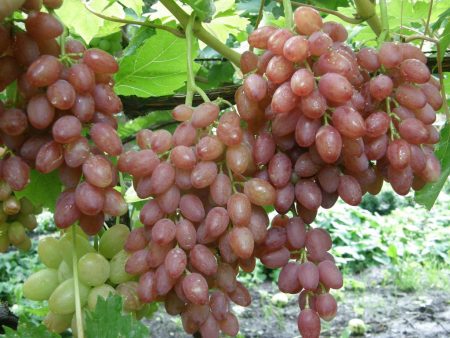
"Radiant raisins" is a relatively new variety of Moldavian selection. Widespread due to the mass of advantages.
Summer residents fell in love with grapes for their unpretentiousness to growing conditions and excellent taste characteristics. Good immunity and high productivity have made "Radish raisins" popular when cultivated on an industrial scale.
Content
general characteristics
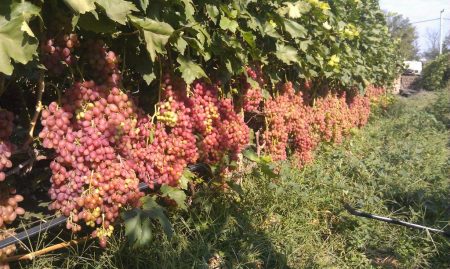
"Radiant raisins" refers to varietal crops. It was bred about 30 years ago at the Moldavian Institute of Viticulture and Winemaking as a result of the pollination of two varieties “Cardinal” and “Pink Chesmish”.
Grapes are included in the group of varieties of medium ripening. From the moment of bud blooming to the ripeness of the berries, about 125-135 days pass. Depending on weather conditions, these periods may vary slightly. Most often, harvesting occurs in the first half of September.
You can get a grape harvest in almost any region of the country, except in the far north. But you should be aware that the variety has moderate frost resistance and can withstand negative temperatures only up to -15 degrees. Therefore, in the middle latitudes and northern regions, care must be taken to shelter the shrubs for the winter. According to the opinions of winegrowers, the highest results were noted during the cultivation of "Radiant quiche" in the Astrakhan region.
Plant features
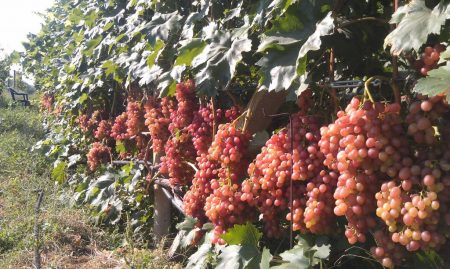
The variety is characterized by a vigorous vine with long spreading shoots. Active growth is observed in the first years after planting. This allows you to use the plant as a decorative decoration for gazebos, open verandas. The peculiarity of the "radiant raptor" is the good flexibility of the vine, so the shoots beautifully encircle obstacles and decorate them.
Leaf plates are strongly dissected, five-lobed, light green in color and medium in size, hold on long stalks and densely cover young shoots. The lower part of the leaves is covered with a barely noticeable white edge. As autumn approaches, the foliage gradually changes color from green to golden.
Fruit Description
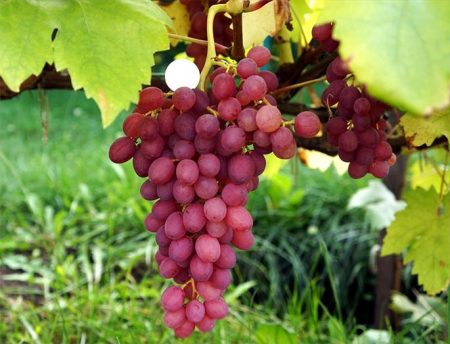
The berries of the variety have the following characteristics:
- large in size (4-5 grams);
- oval shape (22x17 mm);
- pink color;
- dense skin;
- fleshy fleshy, juicy;
- lack of seeds in the pulp;
- sweet taste with nutmeg notes.
Grapes are collected in large clusters, weighing an average of 700-900 grams. And their length can reach 40 cm. According to gardeners, with good care, the mass of the bunch can reach 1.5 kg.
The incredible taste of the berries "radiant" is due to the harmonious combination of sugar and acid. The peculiarity of grapes is a nutmeg aroma, floral notes and a high sugar content in the juice - 21%. The variety has repeatedly won prizes at international tasting competitions.
Productivity
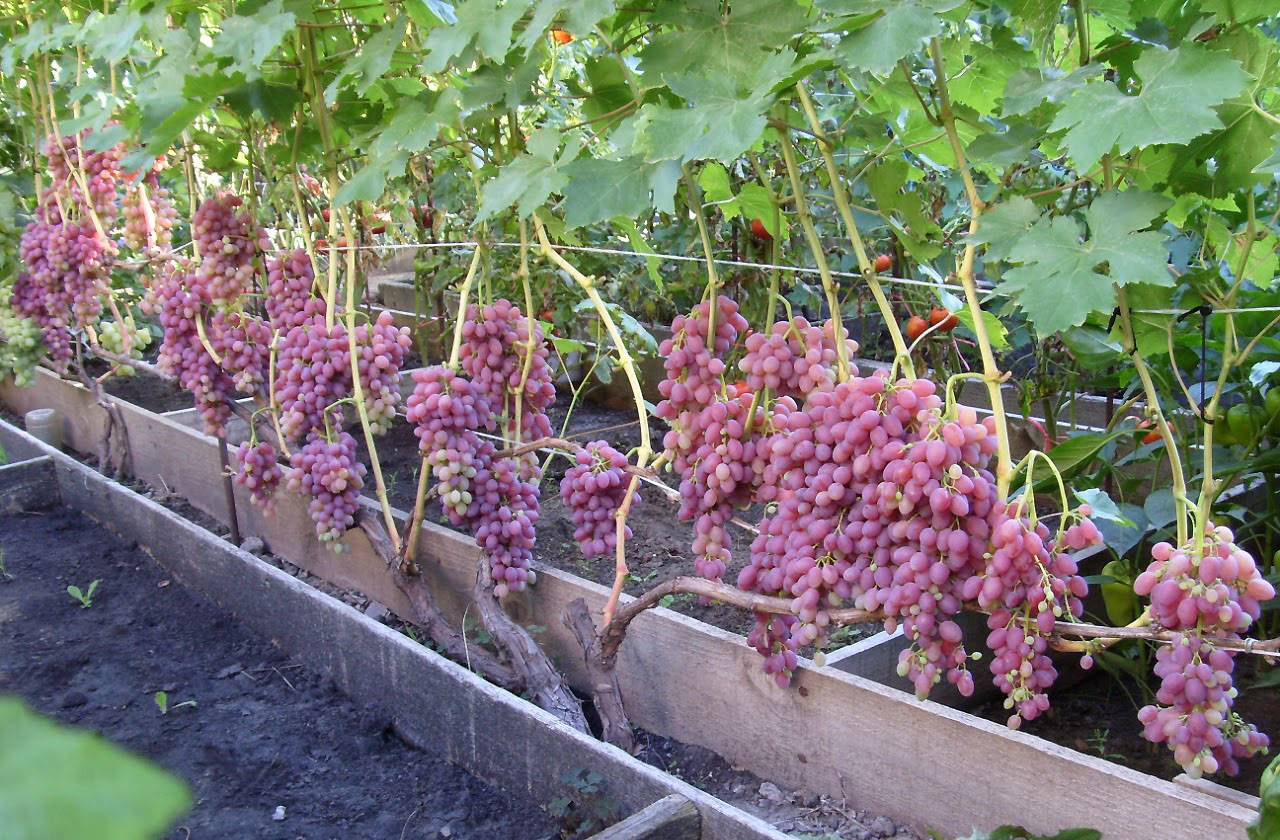
Tall bushes give excellent harvest. More than 30 kg of berries can be collected from one plant in a personal subsidiary farm. Some gardeners managed to get record yields of 50 kg. During industrial cultivation, the following indicators were recorded: from one hectare - 150 centners of grapes. All this characterizes the variety as high-yielding, which is why it is famous among winegrowers.
Berry application
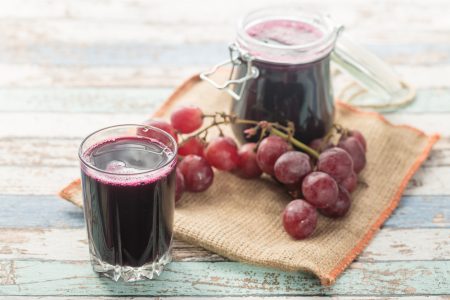
"Radish raisin" variety, universal for its intended purpose.It is good for fresh consumption from the bush. It is used in home and industrial winemaking. Tasty and aromatic juices and compotes from pure grapes, as well as various assortments, are obtained. Thick peel provides good transportability and keeping quality. This allows you to grow grapes for sale. Sweet taste and lack of seeds attract buyers, so the "radiant" one of the most popular varieties on the market for several decades.
Pollination Features
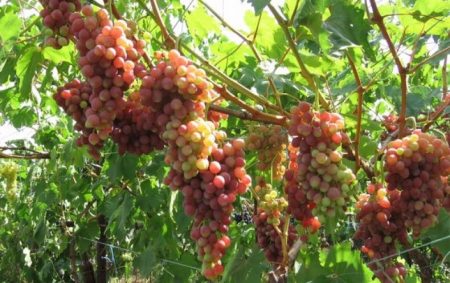
Grapes of this variety do not require pollinating plants. The plant belongs to the dioecious, that is, it has bisexual flowers, in which there is both a stamen and a pistil. Under good weather conditions, the pollination rate of the "radiant swan" reaches a record 90%.
Interestingly, the raisins themselves are a good pollinator for almost all grape varieties. The greatest compatibility is noted with grades:
- Flamingo
- "Laura";
- "Delight is red."
For greater efficiency when planting varieties alternate, while one bush "radiant" is enough for pollination of several plants.
Growing rules and care
Growing grapes cannot be called easy. A strong plant and a good harvest can be obtained only by approaching this process responsibly. For this, it is necessary to carefully study all the subtleties of agricultural technology.
Seedling Selection
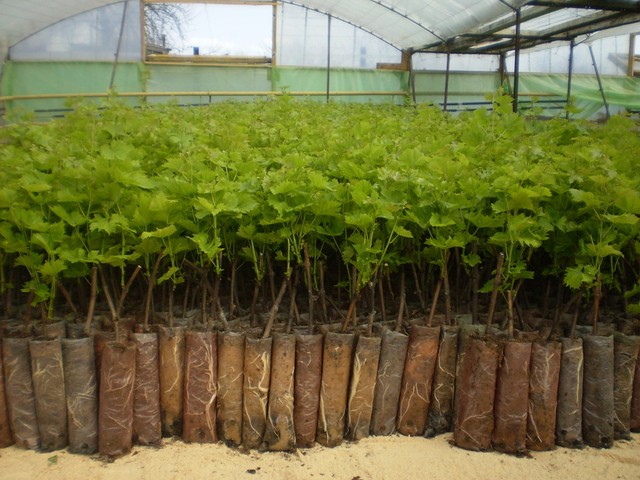
The condition of the future vineyard depends on a correctly selected seedling. It’s easy to get the “right” grape tree, for this you need to use the following memo:
- buy a plant not in advance, but immediately before planting;
- it is better to choose a grafted seedling than root-growing (on the trunk there should be a growth - the junction of the scion and stock);
- Choose a bush with a lot of roots;
- on the cut, the roots should be white and moist (to check, you need to pinch off the root tip with a secateurs);
- the kidneys should not peel off and fall off;
- neighboring seedlings should not have signs of illness (in this case, all plants are likely to be infected).
To buy grapes go to a nursery or a large shopping center.
Landing rules
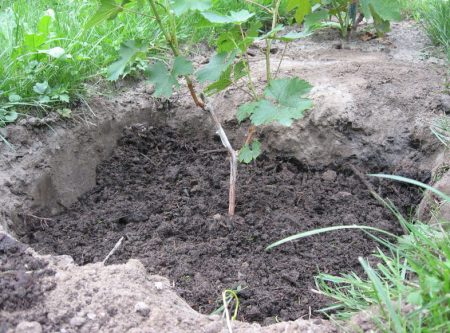
In order for the grapes to take root well on the site and grow and develop safely, it is necessary to observe simple planting rules:
- You can plant grapes in both spring and autumn. In the middle latitudes and the Moscow Region, spring planting is preferable; in the more southern regions, the timing is not critical;
- the place for the vineyard should be well warmed up by the sun;
- when planting several bushes, it is important to observe an interval of 2-2.5 meters;
- "Radiant raisins" does not tolerate drafts, so the landing site should be protected from cold, gusty winds;
- it is good to build a screen or a high fence next to the vine in the east-west direction;
- the landing pit is prepared 1-2 months before planting, its size should be 80x80x80;
- the bottom of the pit is filled with a layer of drainage (broken brick, expanded clay, crushed stone);
- the prepared pit is filled with nutritious soil (4 buckets of humus, 1 bucket of sand, 2 buckets of sod land, 1 liter can of ash);
- when planting, the seedling must be tilted at an angle of 45 degrees in the direction of the future support (trellis);
- at the same time as a seedling in the pit, an irrigation pipe is installed (one end is located on the drainage, and the second rises 20-30 cm above the soil surface);
- the distance between the grapes and the trellis should be 20-25 cm;
- the vaccination site should be above the surface of the soil, and not buried;
- after planting, the grapes are watered with warm water (2 buckets per bush).
Bush management rules and pruning basics
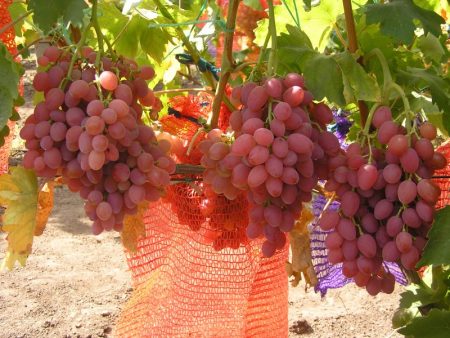
Agrotechnicians recommend cultivating the cultivar "kishmish radiant" to keep the bush in two or four vines, no more. The length of each should be about one meter. The lower part of the vine forms a sleeve, and the upper is intended for fruiting.
The procedure for trimming raisins should be gentle. On new shoots, it is enough to remove 2-3 eyes, on old ones - 8-10. The number of clusters must be carefully controlled. Overloading the plant will lead to potassium starvation, deterioration in taste and shredding of berries. For one shoot, do not leave more than 1-2 large clusters.
A plant overloaded with a large number of clusters significantly increases the ripening time.
Watering and feeding
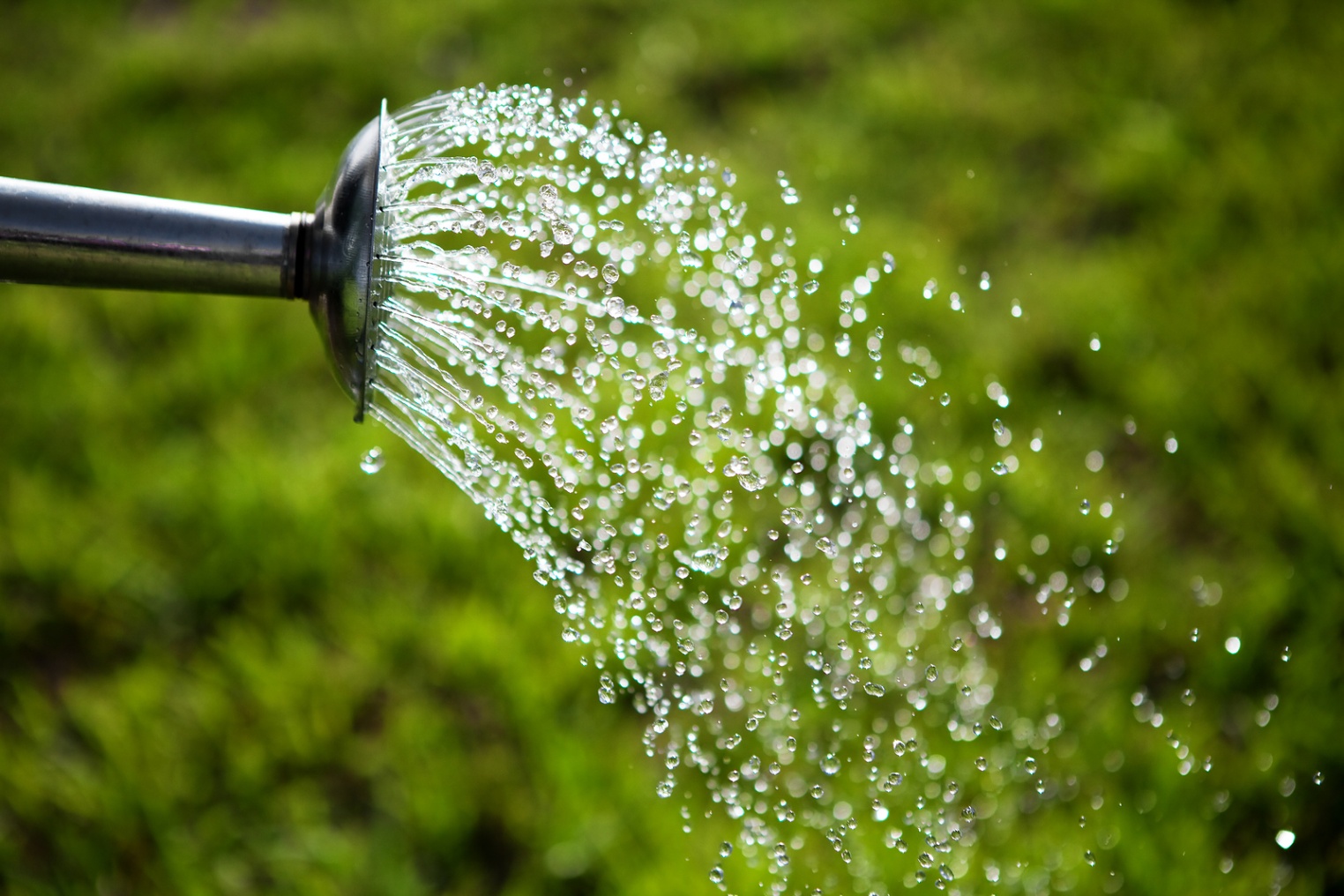
Watering should be regular and moderate. On loamy soils, the consumption per bush is 5-6 buckets, and for soils with a high sand content, 8-9 buckets. Frequency is determined based on weather conditions. So in dry weather, two irrigations per week are enough.
Top dressing "radiant raisin" is carried out in accordance with the general scheme of top dressing of grapes. In the spring, nitrogen fertilizers are applied, in the middle of the season, complex formulations, and in the autumn, fertilizers with a high content of phosphorus and potassium. When calculating the norms of feeding, it should be remembered that raisins do not tolerate overfeeding. Excessive nutrition results in color retention and poor ovary formation.
Preparing for the winter season
A temperature below -15 degrees is detrimental to the roots and the "radiant" vine. Therefore, in regions where lower temperatures are typical for the winter season, care must be taken to shelter the bushes. For shelter you can use straw mats, spruce spruce branches, spanbond. Young bushes are covered with "pyramids" from a wooden frame, and then with covering material. Adult grapes before shelter are tied and bent to the ground.
Fight against ailments and parasites
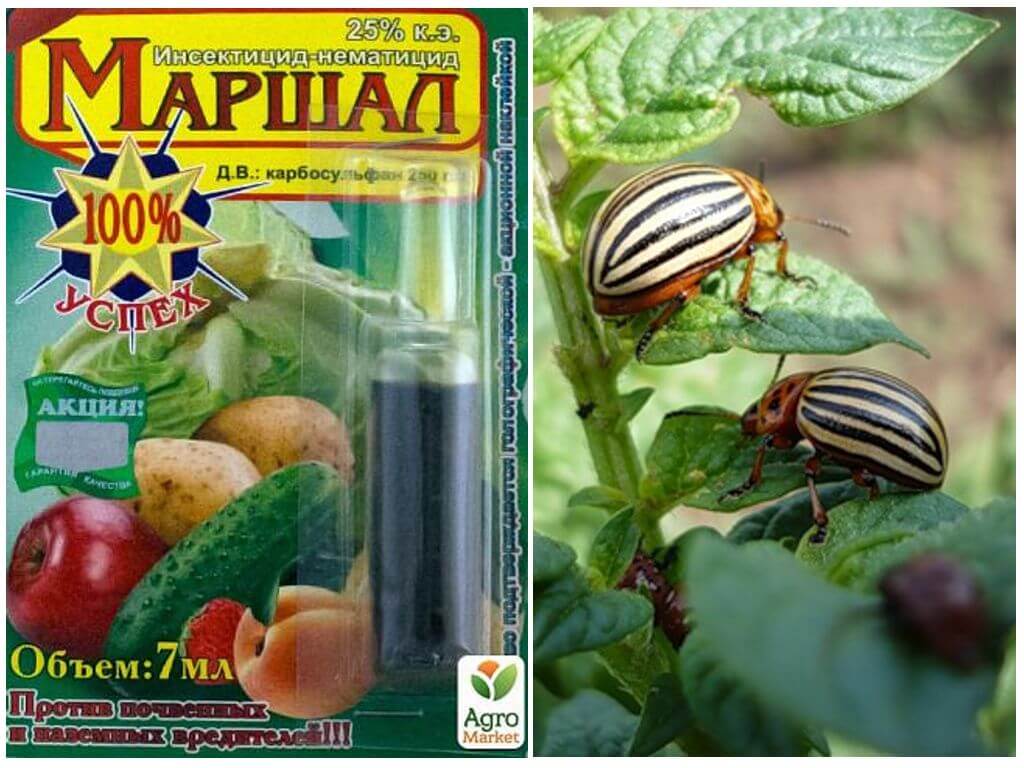
The variety does not have strong immunity to ailments. Especially dangerous is the defeat of diseases such as mildew and root phylloxera. To prevent these and other ailments, it is important to carry out preventive treatments. Bordeaux fluid and such drugs as Hom, Marshal, Confidor and others are recognized as effective means in the fight.
According to gardeners, the variety is not often attacked by pests. The most unpleasant phenomenon is the attack of wasps during the ripening of sweet berries. In this case, you can resort to fumigation with "liquid smoke". Gardeners consider installing poisoned baits a good tool to combat annoying insects.
Pros and cons of the grade "raisin raisin"
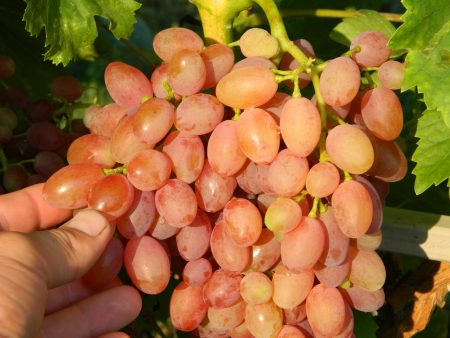
Among the varieties with similar ripening and the absence of seeds, "radiant sultana" has undeniable advantages:
- annual high yield;
- excellent transportability of berries;
- simultaneous ripening of the crop;
- presentation of the fruit;
- pitted sweet fruits;
- easy care;
- self-fertility, which allows a single landing;
- bisexual flowers, allowing you to plant on the site only one bush.
The relative disadvantages of winegrowers include:
- weak immunity;
- average winter hardiness.
Reviews
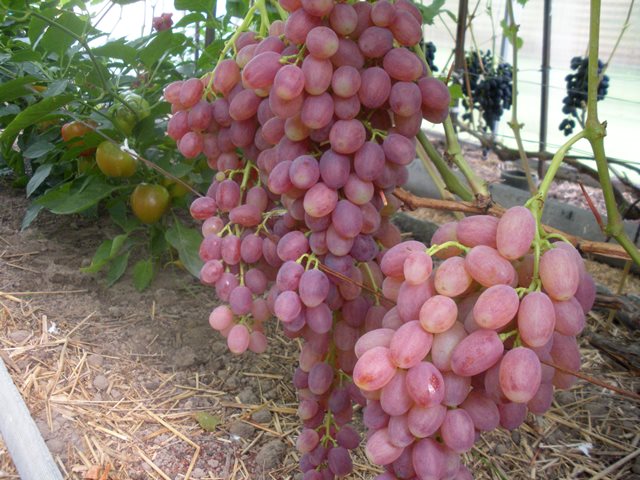
Ekaterina Vasilievna, Ivanovo region
My "radiant" grape is over fifteen years old. The bush during this time turned into a good grape tree. The trunk is well lignified and increased in diameter to 3-4 cm. We grow grapes near the southern wall of the house at a distance of about a meter. Wooden support, from felled branches and old trees. In total, we have formed two sleeves on two sides. I think this is the most convenient way to grow. Over the years of growth, she noted that my raisins respond best to chicken droppings mixed with hay. We have our own chickens, so we continue to spread “chicken” fertilizer under the bush twice a year. The berries as described are very sweet with a nutmeg.
Evgenia, Moscow region
Great grape variety.I really wanted to plant delicious seedless grapes in the garden. Since with seeds, Isabella is already growing and bearing fruit. I chose the "radiant". Grapes are already seven years old. The taste of berries is a solid five. Productivity even in our climate is amazing. Among the shortcomings are too large clusters for such flexible vines, the need to shelter for the winter and the abundance of wasps near the bush. The problem with wasps was solved with the help of traps from plastic bottles with a sweet bait, and under the branches with large clusters we put props from the branches.
Conclusion
"Radiant raisins" is one of the best varieties of seedless grapes, according to winegrowers. Numerous advantages of grapes more than cover minor flaws. Having studied the main characteristics of the variety, as well as the features of plant care, even an inexperienced gardener will be able to get an excellent harvest.




 Non-covering winter-hardy grape varieties for Moscow region
Non-covering winter-hardy grape varieties for Moscow region How to keep the vine in winter
How to keep the vine in winter When can I transfer grapes to another place in the fall
When can I transfer grapes to another place in the fall How to cover and prepare grapes for the winter in the suburbs
How to cover and prepare grapes for the winter in the suburbs